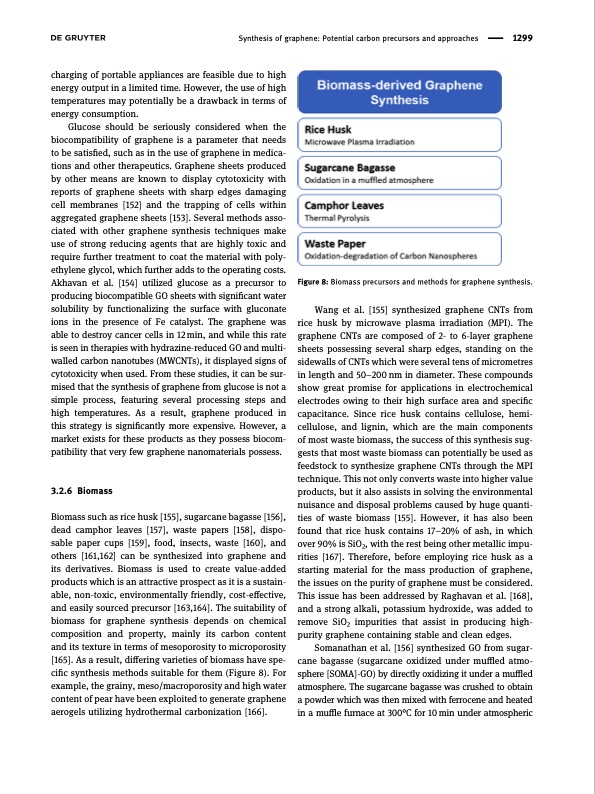
PDF Publication Title:
Text from PDF Page: 016
Synthesis of graphene: Potential carbon precursors and approaches 1299 charging of portable appliances are feasible due to high energy output in a limited time. However, the use of high temperatures may potentially be a drawback in terms of energy consumption. Glucose should be seriously considered when the biocompatibility of graphene is a parameter that needs to be satisfied, such as in the use of graphene in medica- tions and other therapeutics. Graphene sheets produced by other means are known to display cytotoxicity with reports of graphene sheets with sharp edges damaging cell membranes [152] and the trapping of cells within aggregated graphene sheets [153]. Several methods asso- ciated with other graphene synthesis techniques make use of strong reducing agents that are highly toxic and require further treatment to coat the material with poly- ethylene glycol, which further adds to the operating costs. Akhavan et al. [154] utilized glucose as a precursor to producing biocompatible GO sheets with significant water solubility by functionalizing the surface with gluconate ions in the presence of Fe catalyst. The graphene was able to destroy cancer cells in 12 min, and while this rate is seen in therapies with hydrazine-reduced GO and multi- walled carbon nanotubes (MWCNTs), it displayed signs of cytotoxicity when used. From these studies, it can be sur- mised that the synthesis of graphene from glucose is not a simple process, featuring several processing steps and high temperatures. As a result, graphene produced in this strategy is significantly more expensive. However, a market exists for these products as they possess biocom- patibility that very few graphene nanomaterials possess. 3.2.6 Biomass Biomass such as rice husk [155], sugarcane bagasse [156], dead camphor leaves [157], waste papers [158], dispo- sable paper cups [159], food, insects, waste [160], and others [161,162] can be synthesized into graphene and its derivatives. Biomass is used to create value-added products which is an attractive prospect as it is a sustain- able, non-toxic, environmentally friendly, cost-effective, and easily sourced precursor [163,164]. The suitability of biomass for graphene synthesis depends on chemical composition and property, mainly its carbon content and its texture in terms of mesoporosity to microporosity [165]. As a result, differing varieties of biomass have spe- cific synthesis methods suitable for them (Figure 8). For example, the grainy, meso/macroporosity and high water content of pear have been exploited to generate graphene aerogels utilizing hydrothermal carbonization [166]. Figure 8: Biomass precursors and methods for graphene synthesis. Wang et al. [155] synthesized graphene CNTs from rice husk by microwave plasma irradiation (MPI). The graphene CNTs are composed of 2- to 6-layer graphene sheets possessing several sharp edges, standing on the sidewalls of CNTs which were several tens of micrometres in length and 50–200 nm in diameter. These compounds show great promise for applications in electrochemical electrodes owing to their high surface area and specific capacitance. Since rice husk contains cellulose, hemi- cellulose, and lignin, which are the main components of most waste biomass, the success of this synthesis sug- gests that most waste biomass can potentially be used as feedstock to synthesize graphene CNTs through the MPI technique. This not only converts waste into higher value products, but it also assists in solving the environmental nuisance and disposal problems caused by huge quanti- ties of waste biomass [155]. However, it has also been found that rice husk contains 17–20% of ash, in which over 90% is SiO2, with the rest being other metallic impu- rities [167]. Therefore, before employing rice husk as a starting material for the mass production of graphene, the issues on the purity of graphene must be considered. This issue has been addressed by Raghavan et al. [168], and a strong alkali, potassium hydroxide, was added to remove SiO2 impurities that assist in producing high- purity graphene containing stable and clean edges. Somanathan et al. [156] synthesized GO from sugar- cane bagasse (sugarcane oxidized under muffled atmo- sphere [SOMA]-GO) by directly oxidizing it under a muffled atmosphere. The sugarcane bagasse was crushed to obtain a powder which was then mixed with ferrocene and heated in a muffle furnace at 300°C for 10 min under atmosphericPDF Image | Synthesis of graphene Potential carbon precursors

PDF Search Title:
Synthesis of graphene Potential carbon precursorsOriginal File Name Searched:
10-1515-ntrev-2020-0100.pdfDIY PDF Search: Google It | Yahoo | Bing
Salgenx Redox Flow Battery Technology: Power up your energy storage game with Salgenx Salt Water Battery. With its advanced technology, the flow battery provides reliable, scalable, and sustainable energy storage for utility-scale projects. Upgrade to a Salgenx flow battery today and take control of your energy future.
| CONTACT TEL: 608-238-6001 Email: greg@infinityturbine.com | RSS | AMP |